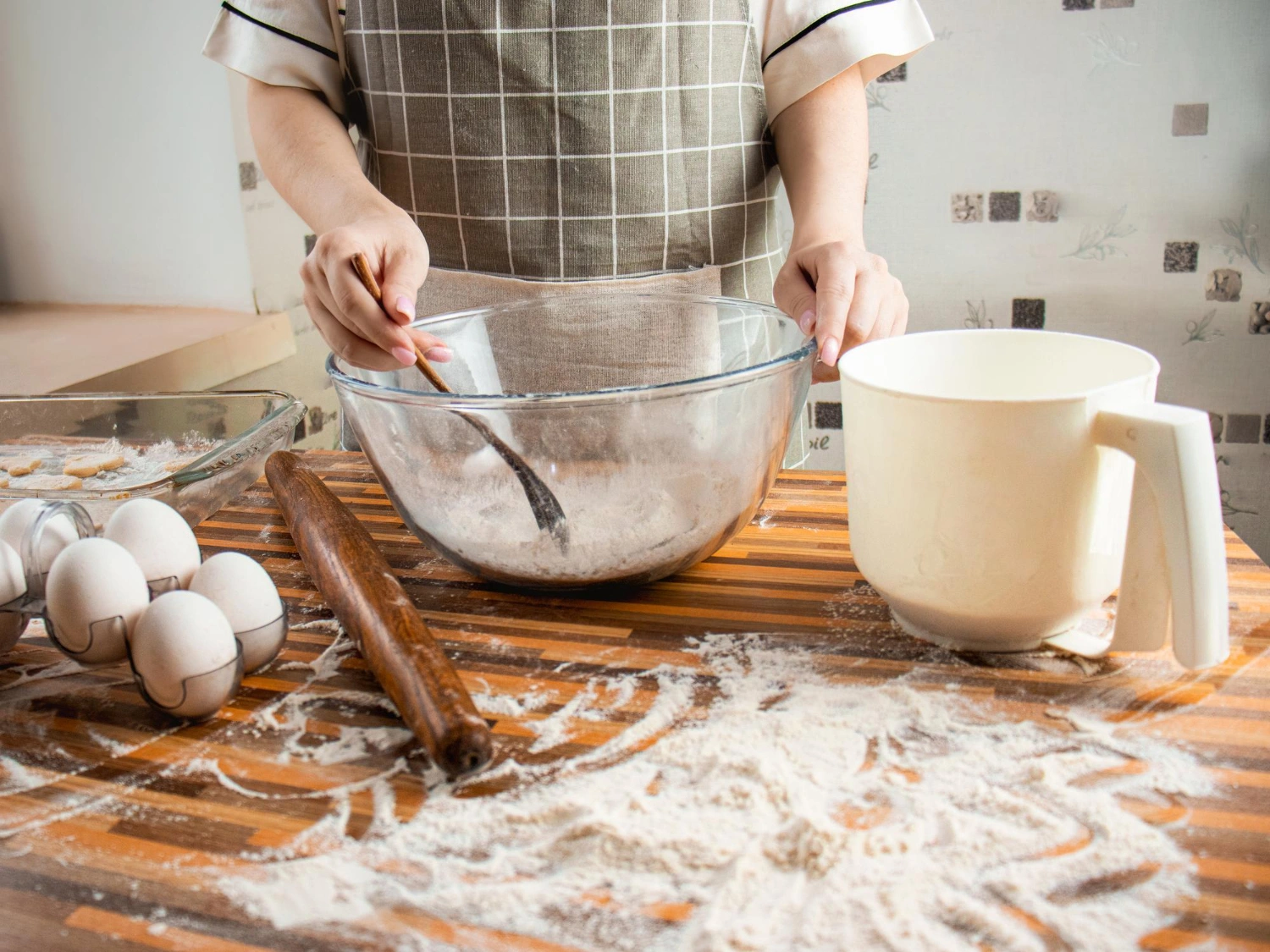Baking mixes are a pantry staple that make it easy to whip up delicious treats without the fuss of measuring out individual ingredients. From cookies to cakes and bread to muffins, these mixes offer a convenient way to enjoy homemade baked goods with minimal effort. Perfect for busy bakers or beginners, baking mixes are versatile, customizable, and a great way to save time in the kitchen.
Why Baking Mixes Are a Must-Have
Baking mixes simplify the baking process by combining essential ingredients into one easy-to-use package. They’re perfect for those last-minute desserts, quick breakfasts, or creative recipes when you don’t have all the ingredients on hand. Whether you’re making a classic dessert or experimenting with new flavors, baking mixes offer consistent results every time.
For more baking inspiration, visit our Baking Category. Pair your creations with our Homemade Butter Recipe for an extra homemade touch.
Popular Types of Baking Mixes
1. Cake Mixes
Perfect for birthday cakes, cupcakes, or layered desserts.
- Customization Ideas: Add fresh fruit, chocolate chips, or swirls of jam for a personal touch.
2. Cookie Mixes
Quick and easy to make classic cookies like chocolate chip, oatmeal raisin, or sugar cookies.
- Pro Tip: Use cookie dough as a base for bars, crumbles, or pie crusts.
3. Pancake and Waffle Mixes
Great for breakfast or brunch.
- Enhancements: Mix in blueberries, bananas, or spices like cinnamon for added flavor.
4. Brownie and Blondie Mixes
Rich, fudgy brownies or chewy blondies are just a mix away.
- Creative Uses: Layer brownie mix with cheesecake batter for a decadent dessert.
5. Bread Mixes
From sourdough to focaccia, bread mixes simplify the bread-making process.
- Tip: Shape bread dough into rolls, baguettes, or even pizza crusts for variety.
How to Customize Baking Mixes
One of the best things about baking mixes is how easily you can customize them to suit your preferences.
- Add Mix-Ins: Stir in nuts, dried fruit, or chocolate chips.
- Use Substitutions: Replace water or milk with buttermilk, yogurt, or fruit juices for added richness.
- Enhance Flavor: Add vanilla extract, citrus zest, or spices like cinnamon and nutmeg.
- Get Creative: Use baking mixes as a base for layered desserts, trifles, or no-bake recipes.
For more creative ideas, explore our Snacks Category.
Tips for Using Baking Mixes
- Follow Instructions: Stick to the package directions for best results, but feel free to get creative once you’re comfortable.
- Check Freshness: Ensure your baking mix is within its expiration date for optimal flavor and performance.
- Don’t Overmix: Overmixing can lead to tough baked goods—mix just until combined.
- Preheat the Oven: Always preheat your oven to ensure even baking.
Pair your baked goods with our French Toast Recipe for a brunch that’s sure to impress.
Serving Suggestions for Baking Mixes
- For Parties: Make bite-sized versions like mini muffins or cookies for easy sharing.
- As Gifts: Prepare baked goods from a mix and package them in decorative boxes or jars.
- For Breakfast: Use pancake or bread mixes to make quick breakfasts paired with eggs or fruit.
- For Desserts: Dress up brownies or cakes with frosting, glaze, or ice cream for a decadent treat.
Nutrition Facts for Baking Mixes
Average per serving (based on a standard portion of a prepared baking mix):
- Calories: 150–250
- Protein: 2–5g
- Carbohydrates: 25–35g
- Sugars: 5–15g
- Dietary Fiber: 1–3g
- Total Fat: 4–10g
- Saturated Fat: 1–4g
- Sodium: 200–400mg
The nutritional content of baking mixes varies depending on the type (pancake mix, cake mix, bread mix, etc.) and added ingredients like butter, eggs, or milk during preparation.
Regional Variations of Baking Mixes
Baking Mixes come in countless varieties, each tailored to different cuisines and preferences:
American Pancake Mix
- Ingredients: Flour, baking powder, sugar, and powdered milk.
- Flavor Profile: Fluffy, sweet, and classic.
- Common Usage: Prepare fluffy pancakes or waffles for breakfast.
Italian Pizza Dough Mix
- Ingredients: High-protein flour, salt, and yeast.
- Flavor Profile: Savory, chewy, and slightly crispy.
- Common Usage: Used for homemade pizzas and flatbreads.
French Crepe Mix
- Ingredients: Fine flour, sugar, and vanilla essence.
- Flavor Profile: Thin, delicate, and slightly sweet.
- Common Usage: Ideal for sweet or savory crepes.
Mexican Cornbread Mix
- Ingredients: Cornmeal, flour, sugar, and baking powder.
- Flavor Profile: Sweet, crumbly, and slightly nutty.
- Common Usage: Serve with chili or as a side for BBQ dishes.
Gluten-Free Baking Mixes
- Ingredients: Almond flour, coconut flour, tapioca starch, and xanthan gum.
- Flavor Profile: Nutty, dense, and versatile.
- Common Usage: For gluten-free breads, cakes, and cookies.
Fun Cooking Techniques for Kids
Engage kids in using baking mixes with these enjoyable activities:
Measuring Ingredients
- Activity: Allow kids to measure and pour the mix and other ingredients.
- Learning Outcome: Introduces math concepts like fractions and volume.
Mixing the Batter
- Activity: Let kids whisk or stir the mix with water, eggs, or milk.
- Learning Outcome: Enhances motor skills and teaches consistency in cooking.
Decorating Baked Goods
- Activity: Encourage kids to decorate cakes, cookies, or muffins with frosting, sprinkles, or fruits.
- Learning Outcome: Sparks creativity and artistic expression.
Shaping Dough
- Activity: Help kids shape cookies, pizza crusts, or bread rolls.
- Learning Outcome: Builds dexterity and introduces them to texture handling.
Kitchen Tools to Elevate Baking Mixes
- Mixing Bowls
- Essential for combining baking mixes with other ingredients.
- Measuring Cups and Spoons
- Ensures accurate proportions for consistent results.
- Whisk or Electric Mixer
- Useful for mixing batters and doughs to the right consistency.
- Silicone Baking Mats
- Prevents sticking and ensures even baking.
- Oven Thermometer
- Ensures the oven temperature is accurate for perfect baking.
- Non-Stick Pans
- Ideal for baking cakes, muffins, and breads.
- Cookie Cutters
- Great for shaping dough into fun, themed designs.
Common Mistakes to Avoid
- Not Reading Instructions
- Always follow the specific instructions on the baking mix package for the best results.
- Overmixing the Batter
- Mix until just combined to avoid dense or tough baked goods.
- Incorrect Oven Temperature
- Use an oven thermometer to ensure the temperature matches the recipe requirements.
- Skipping the Grease or Lining Step
- Grease pans or use parchment paper to prevent sticking.
- Using Old Mixes
- Check expiration dates, as outdated mixes may not rise or taste as intended.
Creative Add-Ins
- Fruits
- Mix in chopped bananas, berries, or dried fruits for natural sweetness.
- Spices
- Add cinnamon, nutmeg, or cardamom for a warm, aromatic touch.
- Nuts and Seeds
- Enhance texture with almonds, walnuts, or sunflower seeds.
- Chocolate
- Incorporate chocolate chips, cocoa powder, or Nutella for indulgent treats.
- Savory Twists
- Use cheese, herbs, or garlic for savory baked goods like muffins or scones.
How to Double or Scale Baking Mix Recipes
- Multiply Ingredients Carefully
- Adjust the quantities of liquids and other mix-ins proportionally.
- Use Larger Pans
- Ensure the pan size matches the increased batter volume.
- Bake in Batches
- For items like cookies or muffins, bake in multiple batches to avoid overcrowding.
- Monitor Baking Time
- Larger quantities may require slightly longer baking times; check doneness frequently.
How to Store Baking Mixes
- Airtight Containers
- Transfer open baking mixes to airtight containers to keep them fresh.
- Cool, Dry Place
- Store mixes in a pantry away from heat and moisture.
- Freezing
- For long-term storage, seal mixes in freezer-safe bags and store for up to 6 months.
- Label with Date
- Mark containers with the purchase or opening date to track freshness.
Baking Mixes in Culture
Baking mixes have revolutionized home baking, making it easier and faster for people to enjoy fresh-baked goods. Originating in the early 20th century, they became popular during the mid-century as a convenient solution for busy households.
From traditional pancakes to artisan bread, baking mixes reflect a fusion of culinary heritage and modern convenience. Today, they continue to inspire creativity in kitchens worldwide.
How to Adapt Baking Mixes for Special Diets
- Gluten-Free Option
- Use certified gluten-free baking mixes and alternative flours.
- Low-Sugar
- Replace sugar with stevia, erythritol, or other natural sweeteners.
- Dairy-Free
- Use almond milk, coconut milk, or soy milk as substitutes.
- Vegan-Friendly
- Replace eggs with flaxseed meal, applesauce, or mashed bananas.
- Keto-Friendly
- Choose keto baking mixes made with almond flour and low-carb sweeteners.
How to Adapt Baking Mixes for Special Occasions
- Holiday Treats
- Add festive touches like peppermint extract, sprinkles, or cranberries.
- Themed Parties
- Use food coloring or shaped pans to match party themes.
- Gift Ideas
- Layer dry ingredients from a baking mix in jars and tie with decorative ribbons for a homemade gift.
- Family Gatherings
- Create a variety of baked goods like muffins, cookies, and breads from the same mix.
- Casual Baking Days
- Use mixes for quick, fun activities with kids or friends.
FAQs About Baking Mixes
Can I make my own baking mix?
Yes! Combine flour, sugar, leavening agents, and salt in a jar to create your own homemade baking mix.
How do I store baking mixes?
Store unopened mixes in a cool, dry place. Once opened, reseal tightly or transfer to an airtight container.
Are baking mixes vegan?
Some mixes are vegan-friendly, but always check the label for animal-derived ingredients like milk powder or eggs.
Can I freeze baked goods made from mixes?
Yes! Most baked goods freeze well. Wrap them tightly and store in a freezer-safe bag for up to 3 months.
How do I make gluten-free baking mixes?
Look for certified gluten-free mixes or create your own using gluten-free flour blends.
Explore More Recipes Like These
If you enjoyed this guide, try:
- Pancake Mix Recipe for a homemade breakfast staple.
- Sourdough Cinnamon Rolls for a sweet and tangy treat.
Baking mixes are a convenient way to enjoy homemade treats without the hassle. With so many varieties and endless customization options, they’re perfect for both everyday baking and special occasions. Try them today and discover how versatile baking mixes can be!

